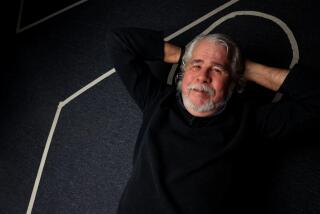Theater / Jan Herman : Changes Fill More Seats at Playhouse
- Share via
When the Laguna Playhouse’s current season draws to a close in two weeks, it will mark the end of Andrew Barnicle’s third year as artistic director of the county’s oldest and second-largest theater company.
During that time, he and executive director Richard Stein have made significant strides toward professionalizing the institution. And they’ve presided over some astonishing, if little noticed, changes in programming and attendance.
This season, for example, despite a 12.5% decline in the subscription base that would give some producers nightmares, more theatergoers have been to the Playhouse than ever.
“Single tickets have been hot,” Barnicle said recently. “They’ve gone through the roof. I think it’s a direct result of the shows we’ve been doing.”
Although the final figures have yet to be tallied, the Playhouse expects to sell nearly double the amount--6,500, or an average of 1,300 per show--projected in the theater’s annual budget at the start of the season.
The box office already has racked up sales of 11,000 single tickets, Barnicle said. And with “The Mystery of Irma Vep” proving to be a big hit midway through its run at the Playhouse’s Moulton Theater in Laguna Beach, single-ticket sales are expected to reach nearly 12,000 for the season.
“They’ve more than made up for the gap in subscriptions,” Barnicle said.
This is not to say he is sanguine about the loss of 1,100 season ticket holders (down from 8,800 to 7,700), which he attributes to a soft regional economy and also, quite candidly, to his own programming choices.
But he makes no apologies.
“‘When I first got here,” he said, “I thought it would be worth it for us to ease off on subscribers if it meant getting new people into the theater. And I think the board is now convinced it’s not such a bad thing to take a dip in the subscription base if you’re going to get a more diverse crowd. Sometimes a theater can be oversubscribed.”
Over the past three seasons, Barnicle has produced a handful of firsts for the Playhouse in an effort to challenge an audience that, rightly or wrongly, had a reputation for unadventurous taste.
*
Among those challenges were plays by Sam Shepard (“True West”), Joe Orton (“What the Butler Saw”), Henrik Ibsen (“An Enemy of the People”) and Charles Ludlam (“Irma Vep”), as well as the first Shakespearean production in 28 years (“A Midsummer Night’s Dream”) and an original comedy by John Twomey (“Teacher’s Lounge”).
Equally striking was the audience’s favorable response. Several of those plays set box-office records, and all are among the 10 highest-grossing, non-musical shows the Playhouse has done, Barnicle said.
“Teacher’s Lounge,” “A Midsummer Night’s Dream” and “True West” are Nos. 1, 2 and 3, followed by Neil Simon’s “Brighton Beach Memoirs,” Alan Ayckbourn’s “Bedroom Farce,” “What the Butler Saw,” “Enemy of the People,” William Inge’s “Bus Stop,” Michael Brady’s “To Gillian on Her 37th Birthday” and Eugene O’Neill’s “Ah, Wilderness!”
Moreover, each of the top 10 shows--plus the overall box-office champ, the musical “Oliver!”--was produced during the past three seasons. And with a record 75% renewal rate of subscribers for next season, the Playhouse clearly is doing something right.
But as much as Barnicle has transformed artistic decisions, he credits Stein for making “even more dramatic changes” in selling the theater to a wider audience.
“Rick has put together a very strong marketing campaign,” he said. “He’s made use of sophisticated advertising techniques. He’s gotten group sales and corporate sponsors on a regular basis for each of the plays. He’s done the sort of things that make a difference.”
Nevertheless, the Playhouse could sell every last ticket to all its shows and still not break even. Like all not-for-profit theater companies, it must raise money in unearned contributions to help defray operating expenses. Roughly 30% of the Playhouse’s $1.2-million budget comes from donations and grants, Barnicle said.
*
COOLING IT: Over at the Alternative Repertory Theatre in Santa Ana, the end of the season also brings good news. “We’ve had a successful year,” said Gary Christensen, a founding member of the company.
Despite a 10% decline in subscriptions to roughly 500, the storefront troupe will finish slightly in the black ($2,000) on an annual budget of about $50,000, also largely due to increased single-ticket sales, Christensen said.
It was mainly the solid success of Lorraine Hansberry’s “A Raisin in the Sun,” with attendance at 80% of capacity in its 61-seat venue, that put ART over the top. (Its current show through June 11, “The Search for Signs of Intelligent Life in the Universe,” is drawing at about 50% of capacity.)
Meanwhile, the troupe’s longtime quest for air conditioning might soon yield results. A cooling unit from a building being torn down by the city of Santa Ana could be donated to ART, Christensen said. If so, that means the troupe would consider extending its schedule into the summer months.
In any case, ART will stage a series of new-play readings during the third week in August. “Where we’ll be doing it depends on the air conditioning,” he noted. “If we don’t get the unit, we may have to find a site somewhere else.” Stay tuned.
More to Read
The biggest entertainment stories
Get our big stories about Hollywood, film, television, music, arts, culture and more right in your inbox as soon as they publish.
You may occasionally receive promotional content from the Los Angeles Times.










